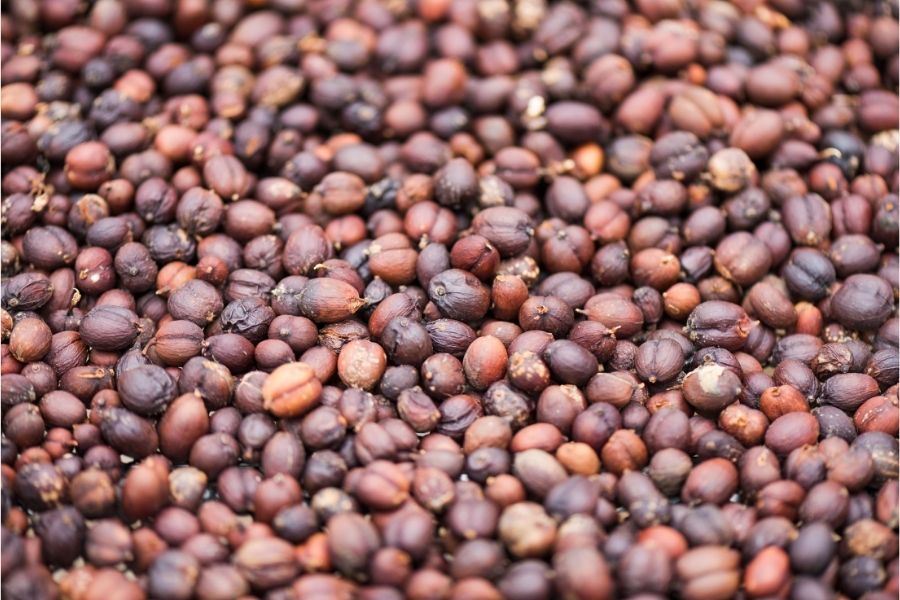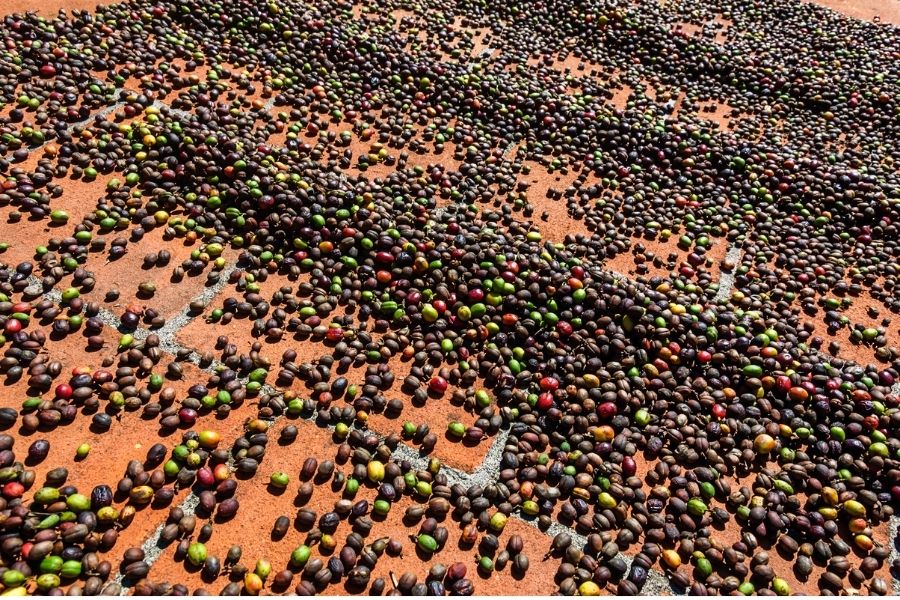
One of the most important components of coffee growing is separating the coffee cherry’s fruit meat and peel from the coffee beans. How to coffee is processed can have a dramatic effect on the resulting cup and nowadays roasters and baristas are concentrating on coffee processing to describe the coffee. Farmers have also begun to experiment with innovative coffee processing technologies such as anaerobic fermentation, which is becoming increasingly popular. Let’s take a look at the most frequent ways to process coffee.
It will need to be dried at some stage – Dry the beans. After the cherries have been descaled and their mucilage removed, washed coffee is dried. Drying occurs while the part or all of the adhesive remains on the parchment in honey processed coffee; in nature, coffee is dried with both its fruit and its mucilage.
There are two main methods for drying coffee. The first method is to put the green coffee beans on a raised bed or in the yard in the sun. The second option is to utilize a specialist coffee dryer.
The purpose of coffee processing for farmers is to separate the bean from the coffee cherry while maintaining the profitability of the crop. Even if the coffee was harvested absolutely ripe and the harvest went well, poor coffee processing might result in faults that reduce the coffee’s value. Some processing methods necessitate more time, investment, and natural resources than others, therefore selecting the best processing method for a coffee farmer or producer can be a critical decision.
Using a drying process to dry coffee beans

Coffee drying is a general post-harvest technique that preserves rather than improves coffee quality. Coffees that are 100% natural washed and processed. At some point throughout the manufacturing process, all must be dried.
Temperature and airflow are the two key factors that lead to dry coffee beans. They diminish the moisture content of the green coffee over time.
It’s critical to remember the temperature restrictions for each processing procedure during the drying coffee beans process. A temperature of more than 40°C should not be used to dry coffee in parchment. Natural coffee is not dried at temperatures higher than 45°C. During various parts of the drying green coffee process, the manufacturer needs to keep the temperature consistent.
To avoid mold growth in the beans, humidity must also be regulated. Before drying, the moisture content will be between 40 and 50 percent. It should also be lowered to between 11 and 12%. The coffee is frequently pre-dried in the sun when using a mechanical dryer. After that, the dryer will be used to finish the process with more precision and accuracy.
One of the most time-consuming coffee bean cultivation and post-harvest drying stages is coffee drying. As a result, this is a significant bottleneck. The length of time it takes for something to coffee drying methods depends on various things. Weather conditions and coffee processing methods processes are included. When the only option is to dry in the sun, coffee that has been washed or partially washed takes less time to dry. The duration varies between six and nine days. Coffee and honey that have been naturally processed will take longer (10 to 14 days).
The dangers of sun-dried coffee beans
Wild fermentation is one of the dangers of sun-dried coffee beans—also, animal contamination and manual drying aren’t done correctly. As well, inclement weather can significantly impact separation quality.
When coffee is not dried rapidly enough, uncontrolled fermentation can occur because bacteria break down coffee’s components. And they produce unfavorable tastes. Coffee beans and animal droppings are harmed by animal contamination, including larger species—for instance, bird droppings in the middle of a coffee drying process. Finally, incorrect manual drying happens when the coffee is not adequately mixed. As a result, temperature and airflow are inconsistent.
Finally, a consistent temperature is required for sun-drying the coffee beans. In addition, there is low humidity without any unfavorable weather or precipitation. Producers may encounter delays or dangers to the quality of their coffee during periods of heavy rain. They may have to put in at least a year’s effort.
Drying coffee beans with a mechanical dryer

ADDITIONAL PROCESSING METHODS
Anaerobic
Anaerobic (oxygen-free) fermentation is a relatively new form of coffee processing that is gaining popularity, particularly among very high-end coffees such as competition coffees. Anaerobic fermentation is similar to washed fermentation, but it takes place in totally sealed, oxygen-depleted tanks. Although the procedure is still in its early stages, anaerobic processed coffees are known for their wild, unexpected, and nuanced flavors.
Maceration of Carbon
This technology is similar to anaerobic fermentation and has been taken from the world of winemaking. The main difference between this procedure and anaerobic fermentation is that the cherries are fermented whole, and the process breaks down the cell walls of the fruit flesh from the inside out. During fermentation, all of the strange flavors from the fruit flesh are soaked into the beans, and carbonic maceration results in highly crazy and fantastic flavors like red whine, whisky, banana, and bubblegum in the cup.
Basah Giling
It may sound unrelated to coffee, but it actually means “wet hulled” in Indonesian. It is only found in Indonesia, as one might anticipate. The technique of giling basah is similar to washed basah, however the beans are dried to just 30-35 percent moisture content (11-12 percent in washed process). The parchment is removed from the beans after first drying, and the “bare” beans are dried again until they are dry enough to store. Giling basah produces earthy characteristics like wood, mustiness, spice, and tobacco, which is why it isn’t well-liked by coffee experts.
Characteristics
There are three significant advantages of using a mechanical dryer over sun-drying coffee. Is the removal of uncontrollable environmental factors that can impact coffee quality. As well as improving accuracy and reducing latency.
Furthermore, the mechanical drier protects the coffee from all types of weather. They can also assist the producer in overcoming their concerns regarding dry, especially in the face of adversity or unpredictability.
Many current rotary coffee dryers have this feature as one of their most essential qualities. It is the system for controlling the drying process. These technologies allow manufacturers to control the temperature of their products. Three different variables were used to create this: the heat source, the air, and the coffee.
Drying control systems allow producers more control in this way. Especially when it comes to the drying process, some systems also allow for creating a “drying curve” by the manufacturer. Interrupt the dryer before the maximum temperature is reached.
Advantage
Many coffee farmers may find that drying coffee in high beds is still a viable alternative. Mechanical dryers, on the other hand, provide a lot of advantages. Drying control systems, for example, give precision to manufacturers. Also, the drying process is more precise.
Rotary dryers have traditionally been used to dry industrial coffee batches. Alternatively, large-quantity coffee. However, thanks to advancements in mechanical drying, they can now be used for specialized manufacture.
Coffee is roasted to provide a typical flavor.
It takes a long time to get from coffee to a completed product. The quality of roasting coffee beans is determined by the most critical stage. It’s time for the coffee to be roasted. To dry the coffee beans, use a modern, high-quality coffee roaster. Most of the flaws in the traditional method are mitigated by this strategy. With the option to change the time, the coffee roasting process may be easier and more efficient. Assist the coffee in reaching the desired temperature. Every roast produces a uniform and mature coffee bean quality.
When using a coffee roaster, all that is required is for the roaster to place the coffee beans into the roasting drum. Then choose a suitable time and temperature. The equipment provides a vacuum atmosphere for the coffee beans in the roasting cage during the roasting process, allowing the beans to ripen evenly as the temperature fluctuates. Burning or uneven ripening should be avoided.
WHERE DOES THE COFFEE GO AFTER IT HAS BEEN PROCESSED?
The parchment coating still surrounds the coffee beans after they have been prepared (unless they are giling basah processed). The moisture content of the beans is now low enough that they can be stored without spoiling. Before being exported, the beans are usually kept in reposo (= dry warehouse) for 1-2 months. The beans are hulled just before shipment to remove the parchment. A dry mill (as opposed to a wet mill / depulper in the washing process) is used to hull the beans mechanically. The beans are graded and sorted after they have been hulled, using equipment that look at the size and color of the beans. The beans can also be separated by hand or using big sieves with varied hole diameters. After sorting and grading the beans, they are packed into 60kg or 69kg jute bags, depending on the place of origin. The jute bags are placed in a shipping container, which safeguards the beans during their long journey to the roastery.